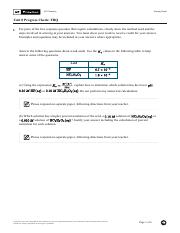Mastering AP Chemistry: Conquering the Unit 9 Progress Check
Are you ready to tackle the challenges of AP Chemistry Unit 9? This comprehensive guide will provide you with the knowledge and strategies you need to succeed on the Unit 9 Progress Check and build a strong foundation for the AP exam. We'll explore the core concepts, delve into effective study techniques, and address common student concerns.
Unit 9 in AP Chemistry typically focuses on applications of thermodynamics, including topics like Gibbs Free Energy, spontaneity, and equilibrium. Understanding these concepts is crucial not only for the Unit 9 assessment but also for future units and the AP exam itself. This progress check serves as a vital checkpoint, allowing you to gauge your understanding and identify areas where you might need further review.
The AP Chemistry curriculum is designed to provide a rigorous, college-level introduction to chemistry. Progress checks, like the one for Unit 9, are integral components of this curriculum. They help students stay on track, assess their learning, and prepare for the cumulative nature of the AP exam. These checks also provide valuable feedback for teachers, allowing them to adjust their instruction and address any misconceptions students may have.
One of the main challenges students face in Unit 9 is applying the concepts of thermodynamics to real-world scenarios. Understanding the theoretical principles is important, but being able to analyze and solve problems related to chemical reactions, equilibrium shifts, and spontaneity requires practice and critical thinking. This guide will equip you with the tools to tackle these challenges effectively.
Understanding Gibbs Free Energy is central to Unit 9. This thermodynamic property helps predict the spontaneity of a reaction. A negative Gibbs Free Energy indicates a spontaneous reaction, while a positive value suggests a non-spontaneous reaction. Factors affecting Gibbs Free Energy include enthalpy, entropy, and temperature. Mastery of these concepts is essential for success on the Unit 9 Progress Check.
Another important aspect of Unit 9 is understanding equilibrium. Chemical equilibrium is a dynamic state where the rates of the forward and reverse reactions are equal. The equilibrium constant, K, quantifies the relative concentrations of reactants and products at equilibrium. Le Chatelier's principle, which describes how equilibrium systems respond to changes in conditions like temperature, pressure, and concentration, is also a key component of Unit 9.
Calculating Gibbs Free Energy and applying Le Chatelier's principle are often challenging for students. Working through practice problems and understanding the underlying principles is crucial for developing proficiency in these areas.
Benefits of mastering Unit 9 material include a deeper understanding of chemical reactions, better preparation for subsequent units and the AP exam, and improved problem-solving skills.
Advantages and Disadvantages of Frequent Progress Checks
| Advantages | Disadvantages |
|---|---|
| Regular feedback on understanding | Potential for increased stress |
| Improved retention of information | Time-consuming for both students and teachers |
Best Practice: Focus on understanding the concepts, not just memorizing formulas. Real-world examples: Consider the Haber-Bosch process for ammonia synthesis or the dissolution of a salt in water.
Challenge: Difficulty applying concepts. Solution: Practice problems and seek clarification from your teacher.
FAQ: What is Gibbs Free Energy? How is equilibrium affected by temperature changes?
Tip: Review your notes regularly and create flashcards for key concepts.
In conclusion, the AP Chemistry Unit 9 Progress Check is a significant milestone in your journey through this challenging yet rewarding course. By focusing on understanding the core concepts of thermodynamics, equilibrium, and Gibbs Free Energy, and by utilizing effective study strategies like practice problems and seeking clarification when needed, you can confidently approach this assessment and build a strong foundation for future success in AP Chemistry. This thorough preparation will not only equip you to excel on the AP exam but will also foster a deeper understanding of the chemical world around us. Commit to consistent effort, seek help when needed, and celebrate your progress along the way. Your hard work and dedication will undoubtedly pay off.
Finding the perfect pre owned toyota rav4 hybrid le near you
Decoding your bikes secret code rim size revealed
Unleash your inner artist crafting flies













